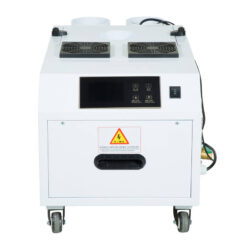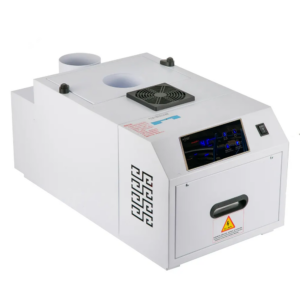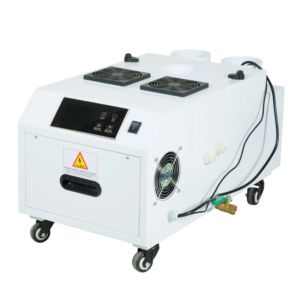Maintaining optimal humidity levels is crucial for various commercial and industrial applications. From delicate seedlings in greenhouses to sensitive equipment in laboratories, proper humidification ensures efficient operations and protects your investments. This article delves into the world of commercial and industrial-grade humidifiers, focusing exclusively on ultrasonic humidifiers and two key mist output capacities: 6kg per hour and 12kg per hour.
Understanding Humidification Needs
The choice of an ultrasonic humidifier and its mist output capacity should be guided by several specific factors related to your application:
-
Space Requirements: The size of the area you need to humidify is a critical consideration. For instance, a 6kg per hour humidifier is typically adequate for smaller greenhouses or labs, whereas larger factories or printshops might necessitate a 12kg per hour unit or even multiple units to achieve uniform humidity distribution.
-
Desired Humidity Levels: Different applications have distinct humidity requirements. Greenhouses often target a humidity range of 50-70% for optimal plant growth, while printshops might require a range of 45-55% to prevent paper jams and curling. It’s essential to research and determine the ideal humidity range for your specific application.
-
Temperature Fluctuations: Seasonal or daily temperature variations can significantly impact humidity levels. In environments with substantial temperature swings, a higher mist output humidifier might be necessary to maintain consistent humidity.
-
Ventilation Rates: Adequate ventilation is crucial to prevent condensation buildup. Spaces with high air exchange rates may require a humidifier with a larger mist output to maintain desired humidity levels consistently.
Ultrasonic Humidifiers: An Overview
Ultrasonic humidifiers generate a cool mist using high-frequency sound waves. They are efficient, quiet, and ideal for applications sensitive to temperature fluctuations. However, they do require regular cleaning to manage mineral buildup. Their versatility and efficiency make them a popular choice for various commercial and industrial settings.
Mist Output Considerations
6kg per Hour Ultrasonic Humidifiers
These units are suitable for smaller to medium-sized spaces, typically up to 1,500 square feet, and applications requiring moderate humidity levels. They are often an excellent choice for:
- Greenhouses: Especially those with young plants, as they help maintain the delicate balance of moisture needed for growth.
- Laboratories: Where specific humidity needs are crucial for research and the operation of sensitive equipment.
- Smaller Printshops: Where maintaining consistent humidity prevents paper curling and ensures high-quality prints.
12kg per Hour Ultrasonic Humidifiers
These units cater to larger spaces, typically up to 3,000 square feet, or environments requiring significant moisture addition. They are ideal for:
- Large Greenhouses: Where maintaining uniform humidity across extensive areas is crucial for plant health.
- Factories: With extensive production lines that need consistent humidity to ensure product quality and worker safety.
- Large Printshops: Managing high-volume printing tasks where consistent humidity prevents paper from drying out and curling.
Additional Features to Consider
When choosing an ultrasonic humidifier, look for these features:
- Humidistat Control: An automatic humidistat maintains preset humidity levels, ensuring efficient operation and preventing over-humidification.
- Ducted or Remote Mount Options: Some humidifiers offer ducting capabilities to distribute mist effectively throughout larger spaces. Remote mounting allows for placement outside the conditioned area, potentially reducing noise and heat generation.
- Automatic Shut-Off: This safety feature prevents humidifier operation when water levels are low, protecting the unit from damage.
Importance of Humidity Control
Humidity control is essential for several reasons:
- Product Quality: In environments like greenhouses, mushroom growhouses, and printshops, maintaining specific humidity levels ensures the quality of plants, fungi, and printed materials.
- Process Efficiency: In factories and laboratories, optimal humidity prevents static electricity, enhances process efficiency, and ensures equipment longevity.
- Worker Comfort: Proper humidity levels improve air quality and comfort, leading to better productivity and health.
Applications
- Greenhouses: Maintaining optimal humidity is crucial for plant health, promoting healthy growth, reducing plant stress during transplantation, and enhancing seed germination rates.
- Mushroom Growhouses: High humidity levels are essential for mushroom cultivation, leading to higher yields, preventing fungal diseases, and enhancing the quality and size of mushrooms.
- Laboratories: Precision is key, and humidifiers ensure accurate experimental results, protect sensitive equipment and samples, and provide a comfortable environment for researchers.
- Printshops: Humidity affects print quality, preventing paper curl and misfeeds, ensuring ink adhesion, and reducing static electricity.
- Factories: Humidifiers improve product quality and consistency, extend equipment longevity by reducing static buildup, and enhance worker comfort and safety.
In summary, selecting the right ultrasonic humidifier with the appropriate mist output capacity is vital for maintaining optimal conditions in various commercial and industrial settings. Understanding your specific humidification needs and considering additional features can help ensure efficient operations and protect your investments.



